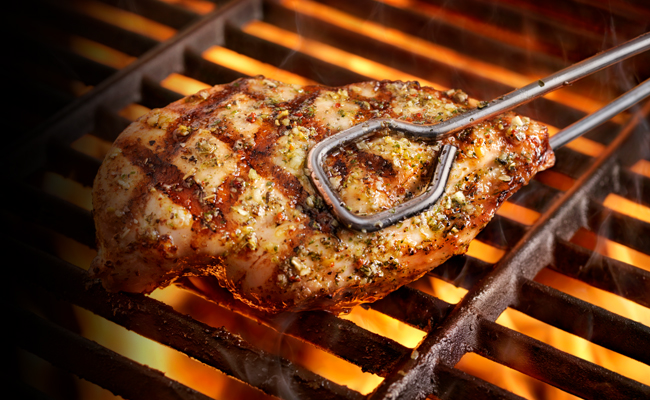Chicken breasts are not a very popular meat for summer BBQs, as they’re perceived as invariably turning out dry and boring. But the truth of the matter is that the problem often lies with the chef and not the meat itself. Over the years I’ve learned a handful of tricks for grilling chicken breasts so that they turn out flavorful and juicy every time.
Read on for how to confidently include this delicious white meat at your next summer grill-out.
The Keys to Grilling Perfect Chicken Breasts
Slice the Cut Horizontally
When grilling any meat, you want a cut with even thickness all around — that’s the only way it’ll have a consistent temperature all the way through. Those giant chicken breasts you get at the store are always lopsided and inevitably cook unevenly. The thin side is done in 10 minutes, but the big end needs another 10 to get to temperature; by that point, half the breast is overdone and too dry to enjoy.
You have a couple options to even out the chicken to make it easier to grill. You could pound out the thick end of the breast, but I’ve always found that to be an unpleasant process. It leads to a mess and makes for misshapen cuts of meat.
My preferred tactic is to use a sharp knife and slice the whole thing horizontally. It’s still inevitably a little uneven, but not nearly as much as before. The internal temperatures may not be totally consistent, but since the cut of meat will be thin anyway, it doesn’t matter as much. You could “butterfly” the cut, which is where you cut horizontally but stop before you go all the way through. In my opinion, though, there’s not much point to that; might as well just go all the way, as it makes for easier handling on the grill and plate.
Salt Ahead of Time
Apply a light layer of salt to your piece of chicken — a “dry brine” — at least a few hours before cooking, up to a full 24. As Samin Nosrat explains in her book Salt, Fat, Acid, Heat, the benefit of this salting, which applies to any kind of meat, is that “the piece of meat remains moister, and you have a greater margin of error for overcooking.”
Juicier chicken, with less risk of a dried-out, overcooked product. Win-win! There’s no reason not to give the meat a dry brine. Here’s how:
- Apply 1/2-3/4 tsp of salt per pound of meat, spreading it evenly over the surface — top, bottom, and sides. It’s not a crazy amount of salt, but most likely more than what you’d normally add. Use kosher or table salt; whatever you have is just fine. If cooking a skin-on breast, note that salt will penetrate the skin; so go ahead and apply directly to the exterior. (As an added bonus, the salt will dry the skin, making it extra crispy and delicious.)
- Stick in…

